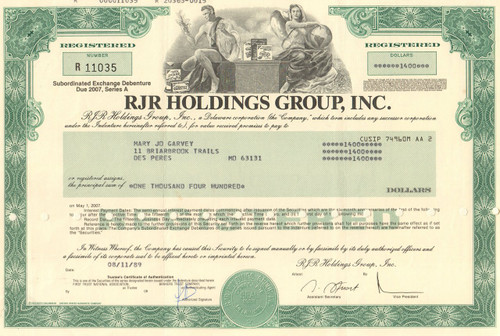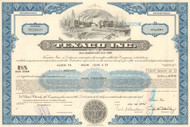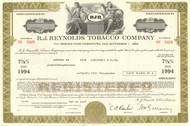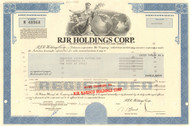Categories
Categories
- Home
- Food and Beverage
- Food Brands
- RJR Holdings Group Inc. bond 1990 (Reynolds-Nabisco)
RJR Holdings Group Inc. bond 1990 (Reynolds-Nabisco)
Product Description
RJR Holdings Group Inc. bond certificate 1990 (Reynolds-Nabisco)
Nice tobacco and food collectible. Cool vignette of classical figures seated with the company's Nabisco products, tobacco field at the lower right. Registered bond. Issued and cancelled. Dated early 1989-1990.
RJR Nabisco, Inc., was an American conglomerate, selling tobacco and food products, headquartered in the Calyon Building in Midtown Manhattan, New York City. RJR Nabisco stopped operating as a single entity in 1999; however, both RJR (as R.J. Reynolds Tobacco Company) and Nabisco (now part of Mondelēz International) still exist.
RJR Nabisco was formed in 1985 by the merger of Nabisco Brands and R.J. Reynolds Tobacco Company. In 1988 RJR Nabisco was purchased by Kohlberg Kravis Roberts & Co. in what was at the time the largest leveraged buyout in history. In 1999, due to concerns about tobacco lawsuit liabilities, the tobacco business was spun off into a separate company, and RJR Nabisco was renamed Nabisco Holdings Corporation. Nabisco is currently owned by Mondelēz International Inc.
RJR Nabisco Holdings Corp. was the parent company of RJR Nabisco, Inc. After the food and tobacco businesses separated in June 1999, Nabisco Group Holdings Corp. owned 80% of RJR Nabisco Holdings Corp., which was the parent company of Nabisco, Inc. R. J. Reynolds Tobacco Company was founded in Winston-Salem, North Carolina in 1875 and changed its name to R. J. Reynolds Industries, Inc. in 1970. It became RJR Nabisco on April 25, 1986 after the company's $4.9 billion purchase of Nabisco Brands Inc. in 1985.
In August 1986, the RJR Nabisco board announced that F. Ross Johnson would replace J. Tylee Wilson as head of the company effective January 1, 1987. Soon after that, Johnson, believing "bucolic" Winston-Salem did not have the right image for a "world-class company", began looking at other possible headquarters cities. On January 15, 1987, the RJR Nabisco board approved a headquarters move from Winston-Salem to Cobb County, Georgia, north of Atlanta. The move would affect 250 to 300 employees, while Winston-Salem would still have 14,000 people working for the company. RJR Nabisco donated the 519,000-square-foot World Headquarters Building to Wake Forest University but continued to use it until the September 1987 move. Later, RJR Nabisco's Planters-Life Savers Division moved to the former headquarters building.
The RJR Nabisco leveraged buyout was, at the time, widely considered to be the pre-emininent example of corporate and executive greed. Bryan Burrough and John Helyar published Barbarians at the Gate: The Fall of RJR Nabisco, a successful book about the events which was later turned into a television movie for HBO. The leveraged buyout was in the amount of $25 billion, and the battle for control took place between October and November 1988.
Although KKR eventually took control of RJR Nabisco, RJR management and Shearson Lehman Hutton had originally announced that they would take RJR Nabisco private at $75 per share. A fierce series of negotiations and proposals ensued which involved nearly all of the major private equity players of the day, including Morgan Stanley, Goldman Sachs, Salomon Brothers, First Boston, Wasserstein Perella & Co., Forstmann Little, Shearson Lehman Hutton, and Merrill Lynch. Once put in play by Shearson Lehman Hutton and RJR management, almost every major Wall Street firm involved in M&A launched frenzied, literal last-minute bids in a fog of incomplete or misleading information.
KKR quickly introduced a tender offer to obtain RJR Nabisco for $90 per share—a price that enabled it to proceed without the approval of RJR Nabisco's management. RJR's management team, working with Shearson Lehman Hutton and Salomon Brothers, submitted a bid of $112, a figure they felt certain would enable it to outflank any response by Kravis. KKR's final bid of $109, while a lower dollar figure, was ultimately accepted by the board of directors. It was accepted because KKR's offer was guaranteed whereas management's lacked a "reset". Additionally, many in RJR's board of directors had grown concerned at recent disclosures of Johnson's unprecedented golden parachute deal. Time Magazine featured Johnson with the headline "A Game of Greed: This man could pocket $100 million from the largest corporate takeover in history. Has the buyout craze gone too far?".
KKR's offer was welcomed by the board, and, to some observers, it appeared that their elevation of the reset issue as a deal-breaker in KKR's favor was little more than an excuse to reject Johnson's higher payout of $112 per share. Johnson received compensation worth more than $60 million from the buyout, then left in February 1989. In March 1989, Louis V. Gerstner of American Express became the new head of RJR Nabisco. On April 27, 1989, RJR Nabisco announced it would move its headquarters to the New York City area. As a result of the acquisition, RJR Nabisco divested the following divisions:
Nabisco's UK operations (including Smith's and Walkers, Belin of France, and Saiwa of Italy were sold to BSN. Smith's and Walkers were swiftly resold to PepsiCo.
Chun King was sold to Yeo Hiap Seng.
Associated Biscuits International (consisting of 38% of India's Britannia and 40% of Pakistan's English Biscuit Manufacturers) to Britannia Industries.
Fresh Del Monte Produce was sold to Polly Peck.
Del Monte Foods was sold to Merrill Lynch, Citicorp Venture Capitol, and Kikkoman. Del Monte's Asia operations (outside the Philippines) were separately sold to Kikkoman.
On March 21, 1991, RJR Nabisco Holdings Corp. became a publicly traded stock. In March 1999, RJR Nabisco announced the sale of the international division of R. J. Reynolds Tobacco, and in June of that year, the company sold the remainder of R. J. Reynolds Tobacco to stockholders. The parent company became Nabisco Group Holdings and owned 80.5 percent of Nabisco Holdings. In 2000, Philip Morris bought Nabisco Holdings. Soon after that, R. J. Reynolds Tobacco Holdings, Inc., first traded in June 1999, announced the acquisition of Nabisco Group Holdings. The deal was completed in December 2000.
 Loading... Please wait...
Loading... Please wait... 








